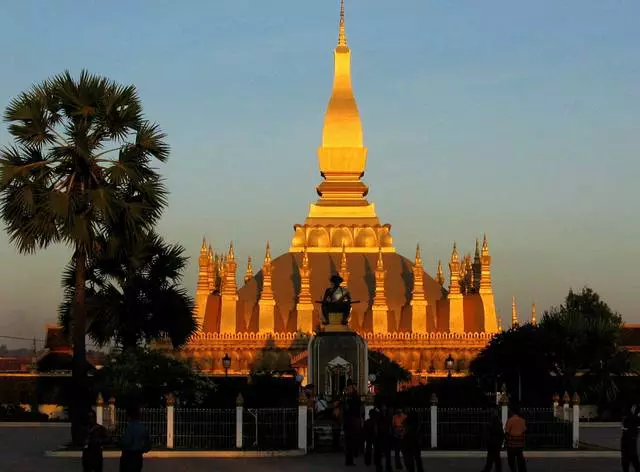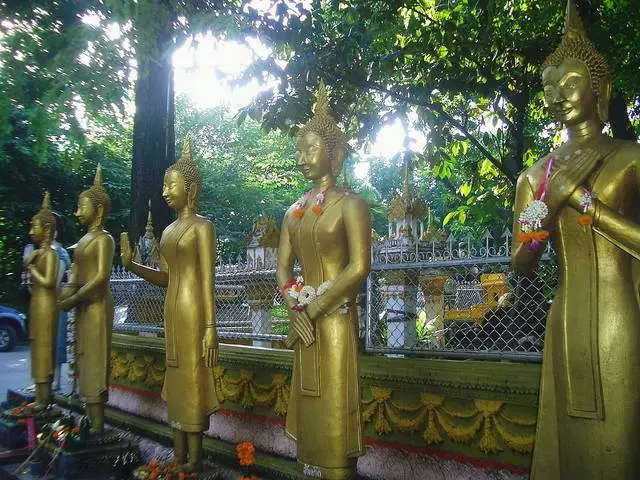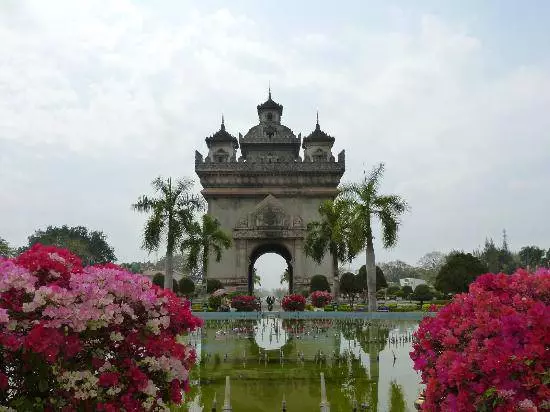Vientiane is the capital of Laos state. The king of Setthalthirate founded this city in the 1560th. Nowadays, a government residence is located here. Vientiane is the smallest capital among others located in the countries of South. This is the largest cultural, economic and administrative center in the country. The locality where it is located is a mefruit of the Mekong River, surrounded by fertile plains. In Vientiane, you can see the architectural heritage, which remained after the French colonists, as well as beautiful Buddhist monasteries and temples and colorful bazaars.
This city does not differ in large sizes - the two main streets are parallel to the Mekong River, and the third is perpendicular to her. Walking or on a bicycle you will get almost to any dot city. In the vicinity of Vientiane, too, there is something to see.
Talk now about major attractions cities
Pha That Luang
This temple is a Buddhist cult building, which is considered the most important architectural landmark in the country, and even this is a symbol of independence of Laos, the image of which is present even on the coat of arms of the state. Fully name for this monument is written as Pho Jedi Locoyulamani, which means "World Precious Sacred Stupa". Under the three levels of the construction implies the postulates of the Buddhist faith. Upstairs of the central stage there is a sculptural decoration - flower. In the height, the temple reaches forty-five meters, you can see the sacred Buddhist inscriptions on the walls.

They built this construction according to the Declaration of the King Sethatchirate in 1566, after the capital "moved" from Luangphabang. Before that, there was an ancient Khmer monastery. By the 1570s, the stupa was surrounded by temples located in the corners, but in our time there are only two of them - Wat That Luang Neua (from the Northern side) and Wat That Luang Tai - with South. The architectural complex is protected by a fence, inside there is a large number of figures - both local - Lao and Khmer. To date, the temple serves as the location of the residence of the Buddhist religious top. Tourists can only be in the courtyard of the complex. Every year the temple becomes a platform for holding a religious event - the festival of a large stupe. It continues throughout the three days, in November, with a full moon - when the twelfth lunar month is going.
Wat Si Saket (Wat Si Saket)
This Buddhist shrine is very famous in the capital of Laos - because it is the only one who survived the destruction in 1827-1828. The syllable "SI" means the respectful attitude of the local population to the temple, it is taken from Sanskrit (the original version is "Sri"). Wat Cakes began to erect in 1818, during the king Chao Anu, the same construction work was completed in 1824. According to the arching style, the building resembles Thai temples, the main local notableness is 6840 Buddha figures - clay, wooden, silver, bronze, which were made in the fifteenth-nineteenth centuries. The location of their location is a niche walking along the inner perimeter of the wall that surrounds this religious building. The figure of Gautama Buddha, sitting under the hooded Cobra, made in the eighteenth century, is located in the Holy Hall. On the ceiling of this room you can see the frescoes that depict the events of the life of the Buddha.
Wat Si Muang (Wat Si Muang)
Wat Si Myang is very honored in Vientiane - according to legend, it is believed that Stele, which is located in the Altar Hall, is the extension of the spirit of the Lao capital - there lives the soul of a pregnant woman Nang Si. Stela was built in the 1563th in accordance with the Decree of the King of Sethatchirate, thanks to which the capital moved to Vientiane. The building was tightened to strong destruction in 1828 - then the Thai-Lao war went. Reconstructed it only in 1915. In the Temple of Si Maang, there is a very large and valuable collection of Buddha figures made of bronze. The entrance to the shrine "is protected" by the figures of the snake and the dog.

Wat Ho Pra Keo (Wat Ho Pra Keo)
Wat Ho Phara Keo is a Buddhist monastery and the royal temple. It was raised at the king of the Set Methathirate to accommodate the figure of the Emerald Buddha, brought to the king from the Thai city of Chiang Mai. In the eighteenth century, this relic was taken by Thais in Bangkok. Since then, Laos has not been able to return it to himself - the result of all their efforts was only a return in the 1994 copy of the sculpture. Here I can see it, visiting the temple of Wat Ho Phara Keo. Here is the Buddha Museum, which also contains statues that were brought from various temples of the state. The temple complex is surrounded by a French garden.
Arch Patusai (Patuxai, ປະ ຕູ ໄຊ)
The arch of the Poupes at first glance is very similar to the Arc Triumphal archway located in the capital of France. She was erected on the main street of the city - on Langsang Avenue - as a tribute to the memory of the dead fighters with the French colonists, as well as in honor of the victory in this liberation war. The arch built on the money of the French government. There are four inputs in the arch, and at the top there are turrets that have similarities with those that are installed on the backs of combat elephants. Building has a decoration in the form of a ornament - lotus colors. Buddha, warriors and elephants are depicted on the blue ceiling. From the sighting platform, located on the arch, you can admire the beautiful view of the Lao capital and its surroundings. In a small store located near the arch, birds are sold in cells - it is believed that if you release one of them to freedom and at the same time make a desire, it will come true.

Lao National Museum (Lao National Museum)
Previously, the Lao National Museum was called the Museum of the Lao Revolution. It is in the construction, in which the residence had previously been located, where the French governor lived. Inspecting the objects of the museum exposition, you will familiarize yourself with the past of this state, with that struggle that people led against the French invaders. In addition, the museum has in his collection by archaeological exhibits of stone and bronze ages, photographs and documents.
The United States in 2007 financially supported the museum, allocation of a grant in the amount of about 27 thousand dollars.
